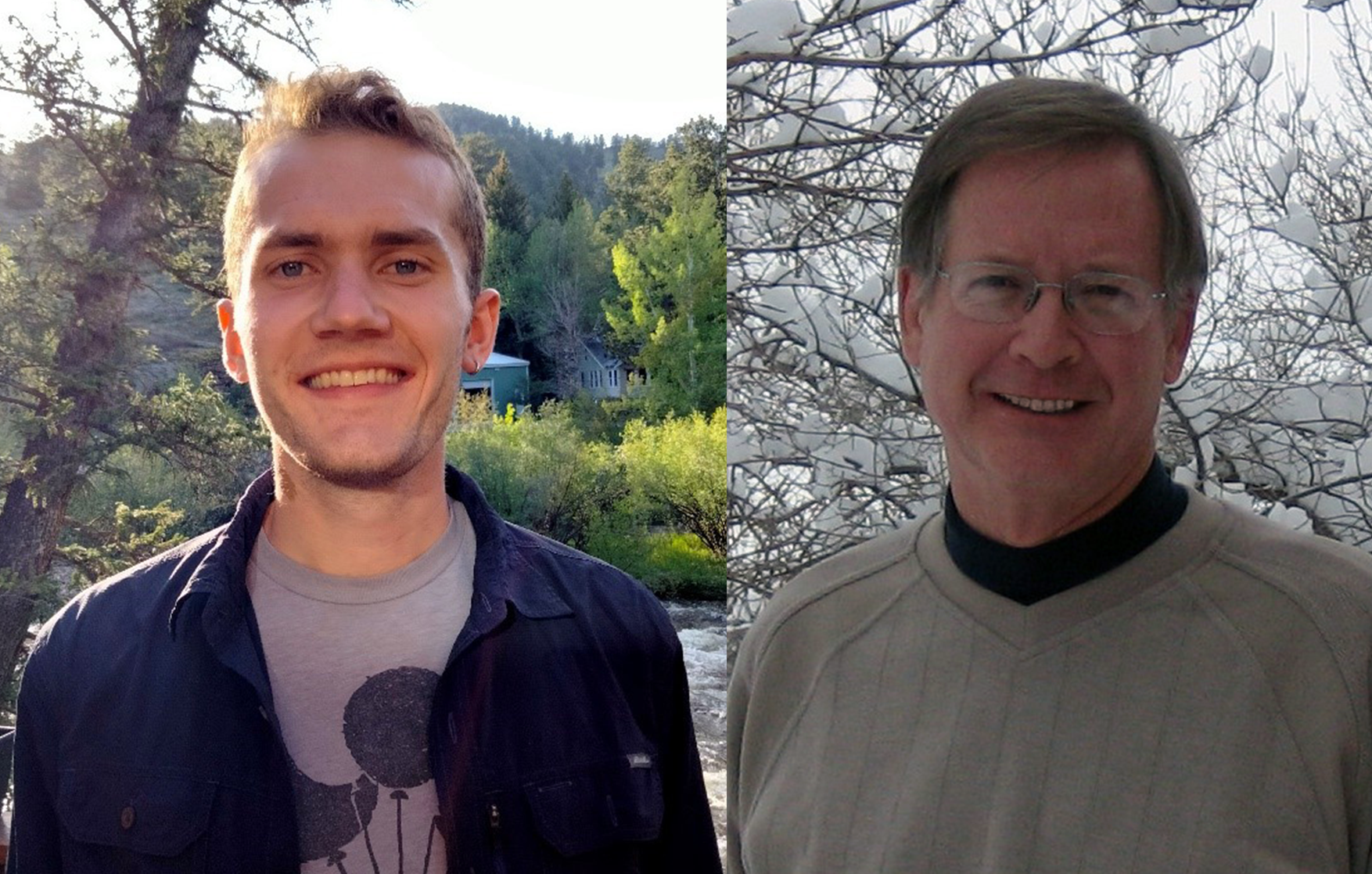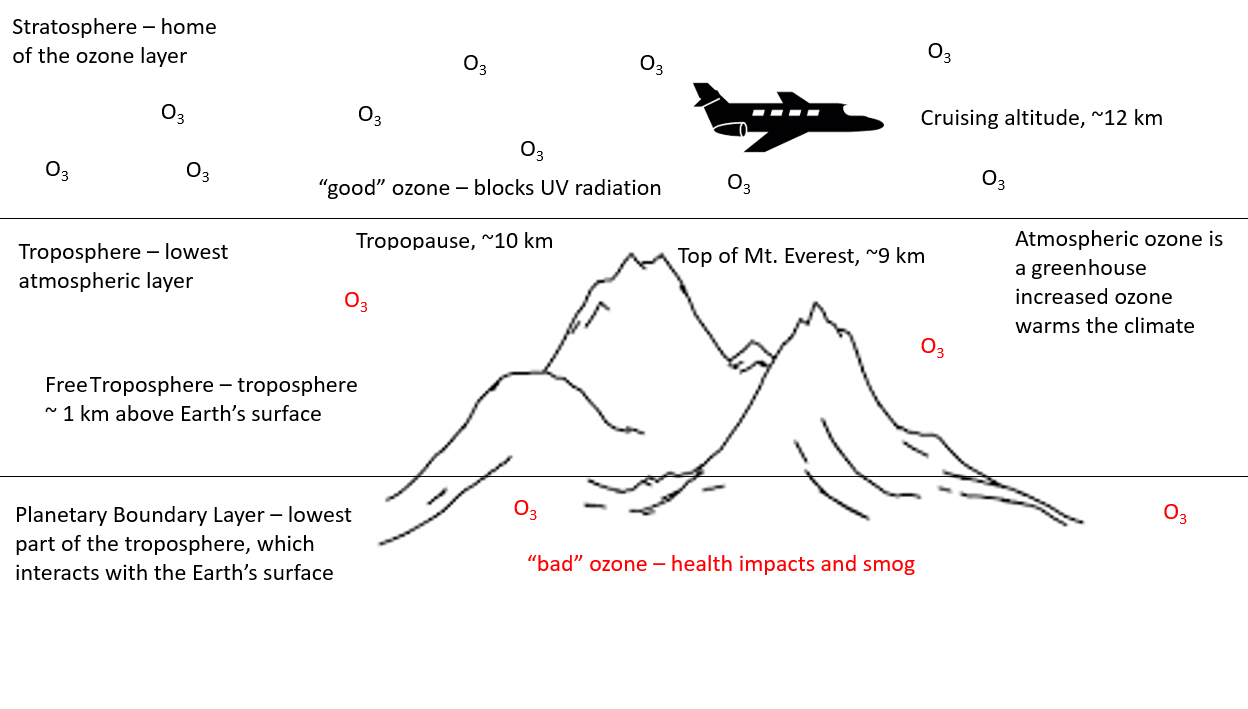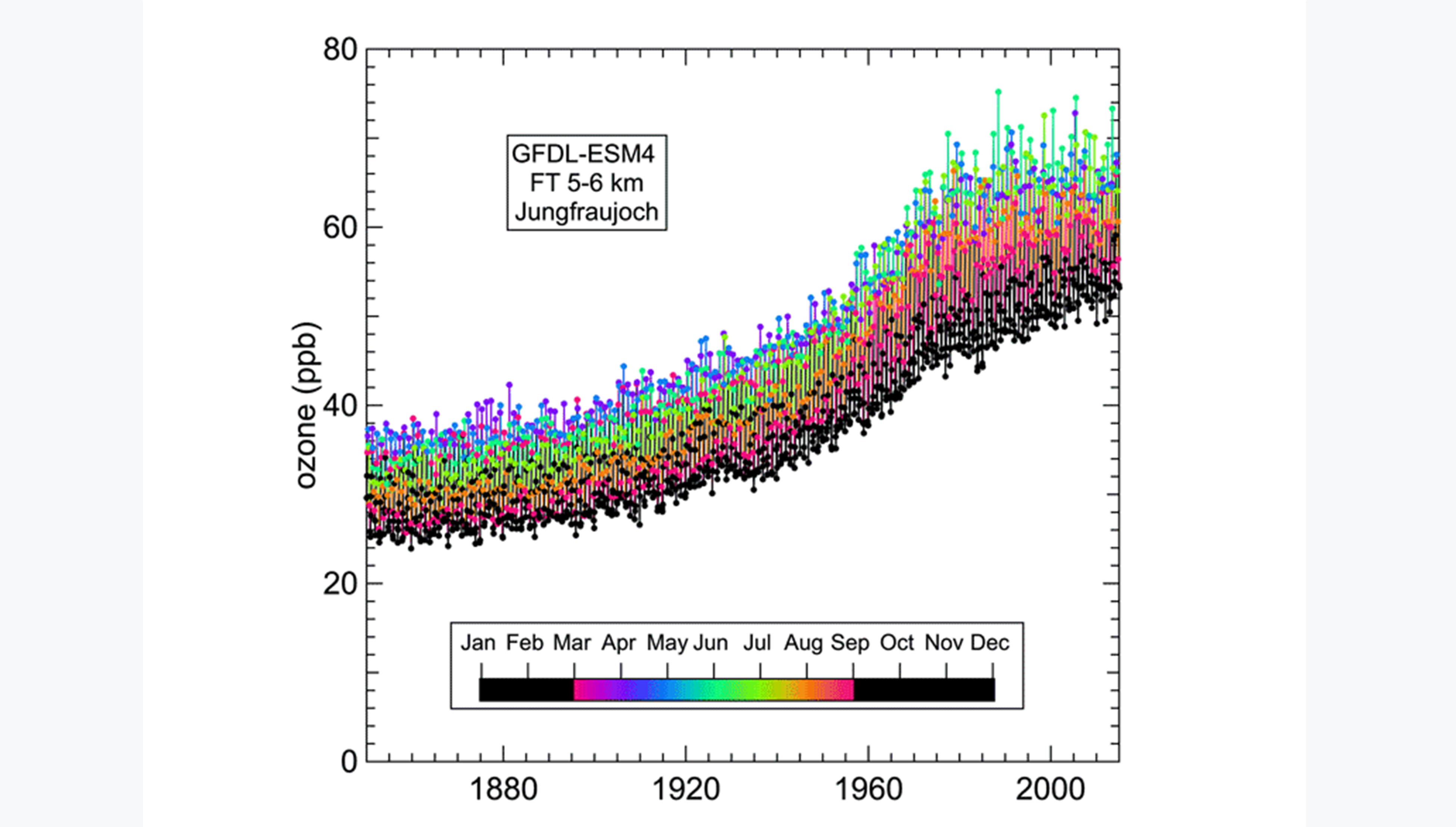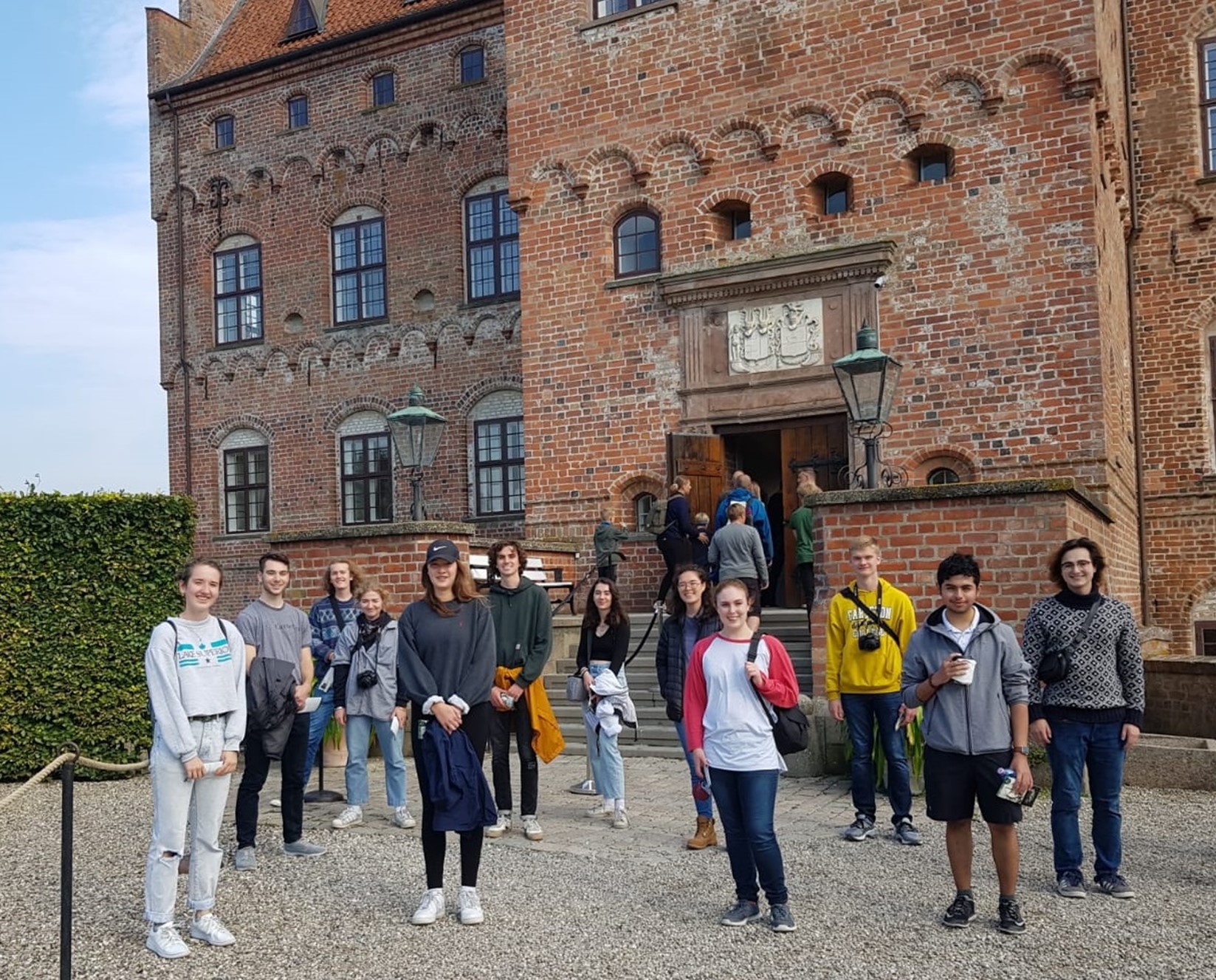How a College Student Turned Pandemic Restrictions
into an Opportunity to Conduct Research
Using NASA Supercomputers

Carleton College physics major Henry Bowman and his advisor, Dr. David Parrish. Photos courtesy of Henry Bowman.
The NASA Center for Climate Simulation (NCCS) wanted to understand how college students managed to keep learning during the global coronavirus disease (COVID-19) pandemic after most college campuses were shut down. We interviewed Henry Bowman, an undergraduate student and physics major who conducted research with a globally distributed team of collaborators in 2020. Bowman used data analyzed with NCCS supercomputing resources and became first author on a paper recently published in a peer-reviewed scientific journal (see “Related Links” at the end of this story).
Hometown: I was born in Summit, New Jersey, and raised mostly in Lafayette, Colorado. I now attend Carleton College in Northfield, Minnesota, studying physics and chemistry.
How did the COVID-related shutdown of early 2020 affect you? What challenges have you had to overcome, and how did you overcome these challenges? When the global pandemic began, the Carleton College campus shut down, and all classes became virtual. As a young person in my formative years, it was really tough to have a lot of opportunities disappear with COVID. I was a freshman in March 2020, when things were also shutting down nationwide during quarantine. That was rigiht at the end of Carleton’s winter trimester, and our classes went fully remote starting with the spring trimester.
There were very few people on campus back at Carleton, except for a handful of international students who were unable to fly back home due to travel restrictions, leaving them stranded on campus for several months. Like most students, I moved back home that spring to attend classes virtually. I was fortunate to be able to return to Colorado during the first few months of COVID quarantine, but the transition to online classes was a difficult one for me.
What did you do during the first year of the pandemic, after campus shut down? I had intentionally chosen a small, liberal arts college to have the opportunity for a lot of close interaction with my peers, so attending virtual college classes from home that spring was not the experience I had looked forward to in high school. At the end of that spring and leading into the beginning of that summer, I looked around for opportunities to do something other than attend college remotely and started the research that went into this paper.
How did this research project get started? I was back home near Boulder, and many of the scientists who work on projects at NOAA are also technically employed by the University of Colorado (CU) Boulder, so there's a lot of crossover between those two institutions near my home. Since my mom is a science writer at CU, she suggested that I reach out to some of the people involved with those two institutions. I ended up reaching out to the leader of one of the groups at NOAA. He put out a message to the scientists in the group, asking if someone had a project that might benefit from having an undergraduate intern conducting data analysis over the summer of 2020. Luckily, he was able to get me involved in an internship project at the Tropospheric Chemistry program in the NOAA Chemical Sciences Laboratory that involved working under the mentorship of Dr. David Parrish. That is when I began the research for this paper.
[Editor’s note: Dr. David Parrish is a retired atmospheric chemist from NOAA, currently a consultant whose research focuses on atmospheric chemistry issues related to air quality and climate change.]
Why is it important to study the free troposphere and ozone? The troposphere is the lowest layer of the atmosphere above the Earth’s surface and is where most weather occurs (see Figure 1, below). Ozone is important in the troposphere for two reasons. First, ozone is a pollutant with detrimental impacts on human and plant health, and second, it is also a greenhouse gas, trapping some of the Sun’s radiation within the atmosphere. At northern midlatitudes, westerly winds transport air around the troposphere in about three weeks, similar to the lifetime of ozone. Therefore, a wide spectrum of local and distant processes impact ozone distribution. It is important to fully understand these processes in order to develop effective air quality policies and understand Earth’s changing climate.

Figure 1: Diagram of Earth’s free troposphere in relation to other atmospheric layers. Figure from Henry Bowman, Carleton College, and David Parrish, David D. Parrish, LLC.
Why study pollution and ozone? We didn't initially plan on investigating the link between pollution and ozone. Rather, those trends became apparent as we looked at the long-term patterns of ozone present in the free troposphere. Every model that we studied simulated the long-term changes between 1850 and 2014, and those changes seemed concurrent with changes in human-caused pollution as industrialization developed. Once we had that first spark of an idea, we went through several iterations of data analysis, going back and forth between the mathematical structure of the data and the physical implications for the mathematical form. That back-and-forth process took us through most of summer 2020, the first year that I worked on the project.
How did you become first author on this paper as an undergraduate student? Dr. Parrish was mentoring me as an intern and was very influential. He suggested that we begin by generally looking at long-term trends in ozone simulations in the six Coupled Model Intercomparison Project Phase 6 (CMIP6) Earth system models. We then noticed these long-term patterns in the ozone time series simulations, where the seasonal cycle was getting broader until around 1980 and then decreasing after that (see Figure 2, below).
Our initial impression was that the data showed evidence of air pollution impacting the seasonal ozone cycle starting around the 1940s, as humans started adding more pollution into the atmosphere. As we investigated this idea further, it became clear that it had the potential to turn into a published research paper. Since I spearheaded the analysis and paper-writing efforts (with a lot of guidance from Dr. Parrish), I became the first author of the paper.

Figure 2: Example time series of 165 years of monthly mean ozone concentrations simulated by the GFDL-ESM4 model in the free troposphere (FT) between 5 and 6 kilometers above Jungfraujoch – a high alpine site in the Swiss Alps with an atmospheric research station located at 3,463 meters (11,362 feet). Sondes, devices that take measurements in accessible locations, are launched from sites in Europe to measure ozone. This plot shows a model simulation above Jungfraujoch, to compare to the sonde measurements. Ozone concentrations are colored according to the month of the year to illustrate the phase shift in the seasonal cycle.

Above the Jungfraujoch saddle, which lies between the two summits of the Mönch peak (left) and the Jungfrau peak (right), rests the Sphinx Observatory, seen in the distance. Photo by Einaz80, CC BY-SA 4.0, via Wikimedia Commons.

An aerial view of the astronomical and meteorological Sphinx Observatory, one of the highest in the world, rising 3,571 m (11,716 ft) above mean sea level. Photo by Julius Silver, CC BY-SA 4.0, via Wikimedia Commons.
What did your research reveal? Our research showed that the shifting seasonal cycle of ozone levels at the northern midlatitudes (between 30°–60° north of the Equator) in Earth’s troposphere is driven by human activities that produce ozone “precursor emissions” – atmospheric pollutants including nitrogen oxides (NOX), non-methane volatile organic compounds (NMVOC), carbon monoxide (CO), and methane (CH4).
Specifically, we proposed that the increasing emission of these “precursors” from human-based pollution then increases the summertime production of ozone – ozone that becomes progressively more important than the natural source of ozone from the stratosphere in the spring – and that these precursors shift the timing of maximum seasonal ozone toward summer, also making the seasonal cycle of ozone larger in size. This is what we think took place between about 1940 and 1980. When human-based pollution decreased, the original changes reversed.
How will this research help improve or impact future Earth system models? The quantitative parameter values that characterize the seasonal shifts in ozone provide useful benchmarks for evaluating model simulations, both against observations and between models.
Where did the data for this research come from? Dr. Steven Turnock provided us with the results of six CMIP6 Earth system model simulations, which are archived in a large-scale data repository at the international Earth System Grid Federation (ESGF). The CMIP6 model simulations were compared with an observational dataset that Dr. Parrish had compiled for an earlier publication, supplemented with additional data from the Tropospheric Ozone Assessment Report (TOAR) data archive.
[Editor’s note: ESGF is an international, inter-agency collaboration between the U.S. Department of Energy, NASA, NOAA, NSF, and a number of international laboratories in Europe and Australia with an overall goal to facilitate advancements in Earth System Science. ESGF stores and manages open-source climate model simulations, satellite observations, and reanalysis products for worldwide distribution.]
How did your team use the high-performance computing resources of the NCCS to conduct your team’s research? Dr. Susanne Bauer and the modeling team at the NASA Goddard Institute for Space Studies (GISS) ran the GISS global climate model on the high-performance computing systems at NCCS. Historical simulations in the GISS model and other Earth system models comprised most of the data we used in this project. This includes hundreds of realizations of transient climate simulations simulating the past as well as future climate scenarios. The large number of simulations covers different model versions, executing different physical and chemical parameterizations, using various forcings, and allowing multiple-ensemble simulation of identical model versions to test climate variability. Enabled by NCCS computing systems, the GISS model simulates atmospheric scenarios that occurred well before reliable ozone measurements were available.
What did you do after your summer internship ended? After my internship was over that summer, I wanted more interaction with my peers, so I applied to a program for Americans to study abroad through the Danish Institute for International Studies (DIIS) based in Copenhagen, Denmark. Organized by Carleton College, a small group of about 50 students participated in this program in 2020, since COVID was a lot worse in the U.S. than in Denmark at that time. I moved to Copenhagen in September 2020, taking in-person classes there with other students until December, rather than staying home in Colorado and attending school virtually by myself.

Henry Bowman (third from the left) and other students from the summer 2020 DIIS Copenhagen program visiting Egeskov Castle on the island of Funen, located near Kværndrup, Denmark. Photo courtesy of Henry Bowman.
How did your time studying abroad in Denmark inform or influence your interest in research? After spending fall 2020 in Denmark and giving a virtual poster presentation from Copenhagen about my research at the American Geophysical Union (AGU) Fall Meeting, I realized that I was still very interested in the project from my recent internship, so I began brainstorming ways to stay involved. I took the winter trimester off from college classes in the first few months of 2021 and resumed my work with Dr. Parrish. During that break, I did a lot of the writing for this published paper and finished up some remaining data analysis.
When did you resume your classes at Carleton College? I returned to campus in spring 2021, but learning was still mostly remote at Carlton, with the exception of a handful of classes such as labs that needed to be completed in person. In fall 2021 and continuing into 2022, all of my classes have been held in person. Things have been a lot more normal recently, both academically and socially, as there have been fewer restrictions and more in-person campus events.
In terms of scientific research and your education, where are you heading next? How have your research experiences influenced your studies or your future plans? I'm still thinking about which area I want to specialize in. I'm studying physics and chemistry now, so atmospheric chemistry is a natural combination, since it's an interdisciplinary field. But there's a chance I might also go into something else. Once I get a little more research experience, I will have a better handle on which kind of graduate programs to consider and start looking into those.
In the immediate future, I will take part in a Research Experience for Undergraduates Sites (REU Sites) program at the University of California, Davis (UC Davis), conducting research as a summer 2022 REU fellow in the university's Physics and Astronomy Department. The REU program is supported by the National Science Foundation (NSF), providing opportunities for undergraduate students like me to acquire hands-on research experience at host institutions across the U.S., working closely with faculty and other researchers and earning a stipend.
What especially inspires you (in school, science, life)? I have loved the outdoors for as long as I can remember. One of my major goals is to use science to protect the natural world around me and preserve the environment for future generations.
What would you like to say to students who are thinking about a career in science? Getting involved in science, especially as a young person, can seem intimidating. As I have become more involved in the scientific community, I realized firsthand how common “imposter syndrome” is. However, I believe there is a place in the scientific community for anyone who wants to take part, so don’t be afraid to put yourself out there! Working in science can be very rewarding. Although it might seem intimidating at first, most groups are very inviting, once you get to know them.
Is there anything else that you would like to mention? I’d like to give my sincere thanks to Dr. Parrish. As a young scientist, having an effective mentor is so important, and Dr. Parrish’s continued guidance and support gave me the opportunity to learn about atmospheric chemistry and the process of doing research. More importantly, it helped me grow immensely and find my place in the scientific community, which has been invaluable.
Related Links
- Bowman, H., S. Turnock, S.E. Bauer, K. Tsigaridis, M. Deushi, N. Oshima, F.M. O’Connor, L. Horowitz, T. Wu, J. Zhang, D. Kubistin, and D.D. Parrish, 2022: Changes in Anthropogenic Precursor Emissions Drive Shifts in the Ozone Seasonal Cycle Throughout the Northern Midlatitude Troposphere. Atmospheric Chemistry and Physics, 22, doi:10.5194/acp-22-3507-2022.
- “GISS and NCCS Contribute to CMIP6 International Climate Model Intercomparison Project,” NCCS News Highlight, 4/30/21.
Sean Keefe, NASA Goddard Space Flight Center
June 29, 2022


